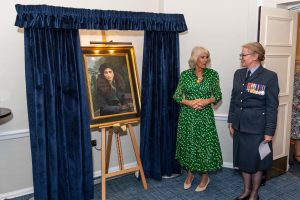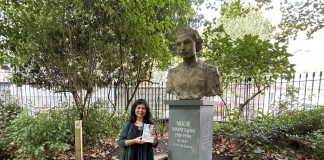Even as the Unite the Kingdom rally descended into violent clashes with its divisive messaging, there was a quiet corner of London that commemorated Noor Inayat Khan – a World War II British Indian heroine who valiantly fought against the forces of hate.
Noor’s memorial stands at Gordon Square to remind future generations of her great sacrifice as a Sufi pacifist and dreamer, who felt compelled to join the war effort on behalf of her country. Her death anniversary, an important milestone in the Sufi tradition of Islam, is marked every year on 13 September – the date in 1944 when she was shot dead, aged just 30, by Nazi forces. Her indomitable spirit shone through in her dying word: “Liberte” or freedom.
“She was an unlikely spy. As a Sufi she believed in non-violence and religious harmony. Yet when her adopted country needed her, she unhesitatingly gave her life in the fight against fascism. That is an important message that continues to resonate strongly for Britain today,” said Shrabani Basu, Noor’s biographer who penned Spy Princess: The Life of Noor Inayat Khan.

“It is important to remember what she sacrificed her life for, and which is why we meet at her memorial every year on her death anniversary and remember her courage. Gordon Square always reminds us of Noor because as a child she lived, played and dreamed of fairies right here,” said the London-based author.
A descendant of the 18th century Indian ruler, Tipu Sultan of Mysore, Noor-un-Nisa was born in Moscow in 1914 to Sufi saint father Hazrat Inayat Khan and American mother Ameena Begum. After spending her early years in London, Noor lived with her family in Paris where she studied child psychology at the Sorbonne.
A gifted musician who enjoyed strumming the harp and veena, she was pursuing a career as a children’s writer when the Second World War broke out and the family decided to move back to England to join the fight against fascism. In the UK, Noor enlisted with the Women’s Auxiliary Air Force (WAAF) and went on to train and undertake duties as a wireless operator. Her skills, including French speaking expertise, led to her being handpicked for an interview in London by the Special Operations Executive (SOE) – the independent British Secret Service set up by then prime minister Winston Churchill to conduct undercover surveillance behind enemy lines. Noor’s talent saw her progress towards paramilitary training at secret locations across Britain.
In June 1943, she was flown to France as a wireless operator under the codename ‘Madeleine’.
Even after her undercover network collapsed, Noor bravely chose to stay on in Paris to keep communication channels open as the only transmitting agent from Nazi-occupied France. As a determined young spy, Noor was able to evade the Germans for three-and-a-half months while continuing to transmit messages back to England – gaining notoriety as one of the Nazi’s most-wanted operatives and was eventually captured after being betrayed.
In captivity, she gained the tag of “highly dangerous” and despite brutal beatings and intense torture, she refused to divulge any state secrets. A bruised and battered Noor was transported to the Dachau concentration camp in Germany to be killed but her captors failed to extract even her real name during the torture. It is no wonder that she was awarded the Croix de Guerre, France’s military honour, as well as Britain’s George Cross.
“She was in isolation, tortured and in chains but she kept her spirits up and managed to

reach out to other inmates, scratching her address 4 Taviton Street under her prison bowl – which is now aptly commemorated with an English Heritage Blue Plaque nearby,” said Basu, who had inaugurated the plaque near Gordon Square in 2020.
The annual ceremony at the square has been held since 2012, when Her Royal Highness Princess Anne unveiled the memorial following a fundraising campaign led by the Noor Inayat Khan Memorial Trust. Since then, Noor’s story has become more widely known, with Queen Camilla unveiling the “Noor Inayat Khan Room” and a portrait which hangs at the RAF Club in London since August 2023.
Later that year, Camden Council named a new “Noor Inayat Khan House” council housing block in north London in honour of the war heroine.
“It is wonderful that the residents of Camden voted to name the housing block after Noor Inayat Khan; the people of Camden have truly taken Noor to heart, and she is known and loved in the borough,” reflects Basu.
“At a time when conflict is rife in the world, and countries and communities are divided by gunfire and walls, it is important to remember the values that Noor stood for. She was a Sufi, she believed in religious tolerance, she believed in non-violence and peace between nations. Let us take away her message for peace and harmony,” she added.
The 20th anniversary edition of Spy Princess: The Life of Noor Inayat Khan is published by History Press in September 2025.




